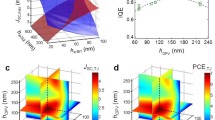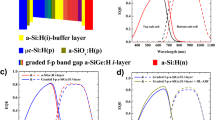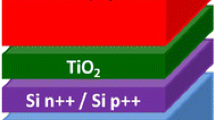Abstract
A novel organic–inorganic hybrid tandem solar cell with inverted structure is proposed. This efficient double-junction hybrid tandem solar cell consists of a single-junction hydrogenated amorphous silicon (a-Si:H) subcell with n-i-p structure as front cell and a P3HT:PCBM organic subcell with inverted structure as back cell. In order to optimize the hybrid tandem cell, we have performed a simulation based on transfer matrix method. We have compared the characteristics of this novel structure with a conventional structure. As a result, a power conversion efficiency (PCE) of 6.1 and 24% improvement compared to the conventional hybrid tandem cell was achieved. We also discuss the high potential of this novel structure for realizing high-stability organic–inorganic hybrid photovoltaic devices.






Similar content being viewed by others
References
J. Kim, Z. Hong, G. Li, T.b. Song, J. Chey, Y.S. Lee, J. You, C.C. Chen, D.K. Sadana, Y. Yang, 10.5% efficient polymer and amorphous silicon hybrid tandem photovoltaic cell. Nat. Commun. 6, 6391–6397 (2015)
L. Dou, J. You, J. Yang, C.C. Chen, Y. He, S. Murase, T. Moriarty, K. Emery, G. Li, Y. Yang, Tandem polymer solar cells featuring a spectrally matched low-bandgap polymer. Nat. Photonics 6, 180–185 (2012)
J. You, L. Dou, K. Yoshimura, T. Kato, K. Ohya, T. Moriarty, K. Emery, C.C. Chen, J. Gao, G. Li, Y. Yang, A polymer tandem solar cell with 10.6% power conversion efficiency. Nat. Commun. 4, 1446–1455 (2013)
A. Shah, J. Meier, E.V. Sauvain, C. Droz, U. Kroll, N. Wyrsch, J. Guillet, U. Graf, Microcrystalline silicon and ‘micromorph’ tandem solar cells. Thin Solid Films 403–404, 179–187 (2002)
T. Kim, H. Kim, J. Park, H. Kim, Y. Yoon, S.M. Kim, C. Shin, H. Jung, I. Kim, D.S. Jeong, H. Kim, J.Y. Kim, B. Kim, M.J. Ko, H.J. Son, C. Kim, J. Yi, S. Han, D.K. Lee, Triple-junction hybrid tandem solar cells with amorphous silicon and polymer-fullerene blends. Sci. Rep. 4, 7154–7159 (2014)
T. Ameri, G. Dennler, C. Waldauf, P. Denk, K. Forberich, M.C. Scharber, C.J. Brabec, K. Hingerl, Realization, characterization, and optical modeling of inverted bulk-heterojunction organic solar cells. J. Appl. Phys. 103(8), 845–850 (2008)
M.J. Tan, S. Zhong, J. Li, Z. Chen, W. Chen, Air-stable efficient inverted polymer solar cells using solution-processed nanocrystalline ZnO interfacial layer. Appl. Mater. Interfaces 5, 4696–4701, (2013)
I. Etxebarria, A. Guerrero, J. Albero, G.G. Palomares, E. Belmonte, R. Pacios, Inverted vs standard PTB7:PC70BM organic photovoltaic devices. The benefit of highly selective and extracting contacts in device performance. Org. Electron. 15(11), 2756–2762 (2014)
X. Wang, Z.M. Wang, High-Efficiency Solar Cells—Physics, Materials, and Devices (Springer, New York, 2014)
T. Kim, J.Y. Choi, J.H. Jeon, Y.S. Kim, B.S. Kim, D.K. Lee, H. Kim, S. Han, K. Kim, Hybrid tandem photovoltaic devices with a transparent conductive interconnecting recombination layer. Mater. Res. Bull. 47(10), 3040–3043 (2012)
Y. Sun, J.H. Seo, C.J. Takacs, J. Seifter, A.J. Heeger, Inverted polymer solar cells integrated with a low-temperature-annealed sol-gel-derived ZnO film as an electron transport layer. Adv. Mater. 23(14), 1679–1683 (2011)
N. Li, T. Stubhan, D. Baran, J. Min, H. Wang, T. Ameri, C.J. Brabec, Design of the solution-processed intermediate layer by engineering for inverted organic multi junction solar cells. Adv. Energy Mater. 3(3), 301–307 (2013)
S. Trost, K. Zilberberg, A. Behrendt, A. Polywka, P. Görrn, P. Reckers, J. Maibach, T. Mayer, T. Riedl, Overcoming the “light-soaking” issue in inverted organic solar cells by the use of Al:ZnO electron extraction layers. Adv. Energy Mater. 3(11), 1437–1444 (2013)
Z. Hong, L. Dou, G. Li, Y. Yang, Tandem solar cell—concept and practice in organic solar cells. In: Progress in High-Efficient Solution Process Organic Photovoltaic Devices, (Springer, Berlin, 2015), pp. 315–346
A. Hadipour, B. de Boer, P. Blom, Device operation of organic tandem solar cells. Org. Electron. 9(5), 617–624 (2008)
S. Sista, Z. Hong, L. M. Chen and Y. Yang, Tandem polymer photovoltaic cells—current status, challenges and future outlook. Energy Environ. Sci. 4(5), 1606–1620 (2011)
W. Qin, W. Yu, W. Zi, X. Liu, T. Yuan, D. Yang, S. Wang, G. Tu, J. Zhang, F.S. Liu, C. Li, High efficiency organic/a-Si hybrid tandem solar cells with complementary light absorption. J. Mater. Chem. A 2(37), 15303–15307 (2014)
J. You, L. Dou, K. Yoshimura, T. Kato, K. Ohya, T. Moriarty, K. Emery, C.C. Chen, J. Gao, G. Li, Y. Yang, A polymer tandem solar cell with 10.6% power conversion efficiency. Nat. Commun. 4, 1446–1455 (2013)
S. Roland, S. Neubert, S. Albrecht, B. Stannowski, M. Seger, A. Facchetti, R. Schlatmann, B. Rech, D. Neher, Hybrid organic/inorganic thin-film multijunction solar cells exceeding 11% power conversion efficiency. Adv. Mater. 27(7), 1262–1267 (2015)
M.C.C. Scharber, D.M. Mühlbacher, M. Koppe, P. Denk, C. Waldauf, A.J. Heeger, Design rules for donors in bulk-heterojunction solar cells—towards 10% energy-conversion efficiency. Adv. Mater. 18(6), 789–794 (2006)
D. Chen, C. Zhang, Z. Wang, J. Zhang, Q. Feng, S. Xu, X. Zhou, Y. Hao, Performance comparison of conventional and inverted organic bulk heterojunction solar cells from optical and electrical aspects. IEEE Trans. Electron 60(1), 451–457 (2013)
M. Jørgensen, K. Norrman, F.C. Krebs, Stability/degradation of polymer solar cells. Solar Energy Mater. Solar Cells 92(7), 686–714 (2008)
B.P. Rand, H. Richter, Organic Solar Cells: Fundamentals, Devices, and Upscaling (CRC Press, Boca Raton, FL, 2014)
F.C. Krebs, Stability and Degradation of Organic and Polymer Solar Cells (Wiley, Hoboken, NJ, 2012)
S. Pattnaik, T. Xiao, R. Shinar, J. Shinar, V.L. Dalal, Novel hybrid amorphous/organic tandem junction solar cell. IEEE J. Photovolt. 3(1), 296–299 (2013)
F. Zhang, X. Xu, W. Tang, J. Zhang, Z. Zhuo, J. Wang, J. Wang, Z. Xu, Y. Wang, Recent development of the inverted configuration organic solar cells. Solar Energy Mater. Solar Cells 95(7), 1785–1799 (2011)
M. Jørgensen, K. Norrman, S.A. Gevorgyan, T. Tromholt, B. Andreasen, F.C. Krebs, Stability of polymer solar cells. Adv. Mater. 24(5), 580–612 (2012)
Author information
Authors and Affiliations
Corresponding author
Rights and permissions
About this article
Cite this article
Bahrami, A., Faez, R. A novel organic–inorganic hybrid tandem solar cell with inverted structure. Appl. Phys. A 123, 222 (2017). https://doi.org/10.1007/s00339-016-0752-x
Received:
Accepted:
Published:
DOI: https://doi.org/10.1007/s00339-016-0752-x




